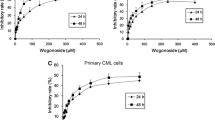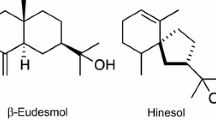Abstract
Wogonin, a flavone in the roots of Scutellaria baicalensis, reduced etoposide-induced apoptotic cell death in normal cells, such as bone marrow cells and thymocytes. On the other hand, wogonin potentiated the proapoptotic or cytotoxic action of etoposide in tumor cells, such as Jurkat, HL-60, A549, and NCI-H226. These contradictory actions of wogonin on apoptosis are distinguished by normal or cancer cell types. Wogonin had no effect on apoptosis induced by other anticancer agents in the tumor cells. Thus, the potentiation effect of wogonin was observed only in etoposide-induced apoptosis in tumor cells. In a functional assay for P-glycoprotein (P-gp), wogonin suppressed excretion of calcein, a substrate for P-gp, in these tumor cells. Moreover, wogonin decreased the excretion of radiolabeled etoposide and accordingly increased intracellular content of this agent in the cells. P-gp inhibitors showed a similar potentiation effect on etoposide-induced apoptosis in these tumor cells. Thus, wogonin is likely to potentiate the anticancer action of etoposide due to P-gp inhibition and accumulation of this agent. These findings suggest that wogonin may be a useful chemotherapeutic adjuvant to potentiate the pharmacological action of etoposide and ameliorate its adverse effects.







Similar content being viewed by others
References
Chi YS, Cheon BS, Kim HP (2001) Effect of wogonin, a plant flavone from Scutellaria radix, on the suppression of cyclooxygenase-2 and the induction of inducible nitric oxide synthase in lipopolysaccharide-treated RAW 264.7 cells. Biochem Pharmacol 61:1195–1203
Lee H, Kim YO, Kim H, Kim SY, Noh HS, Kang SS, Cho GJ, Choi WS, Suk K (2003) Flavonoid wogonin from medicinal herb is neuroprotective by inhibiting inflammatory activation of microglia. FASEB J 17:1943–1944
Shieh DE, Liu LT, Lin CC (2000) Antioxidant and free radical scavenging effects of baicalein, baicalin and wogonin. Anticancer Res 20:2861–2865
Chung H, Jung YM, Shin DH, Lee JY, Oh MY, Kim HJ, Jang KS, Jeon SJ, Son KH, Kong G (2008) Anticancer effects of wogonin in both estrogen receptor-positive and -negative human breast cancer cell lines in vitro and in nude mice xenografts. Int J Cancer 122:816–822
Lee DH, Kim C, Zhang L, Lee YJ (2008) Role of p53, PUMA, and Bax in wogonin-induced apoptosis in human cancer cells. Biochem Pharmacol 75:2020–2033
Liu S, Zhang J, Li D, Liu W, Luo X, Zhang R, Li L, Zhao J (2007) Anticancer activity and quantitative analysis of flavone of Cirsium japonicum DC. Nat Prod Res 21:915–922
Lu N, Gao Y, Ling Y, Chen Y, Yang Y, Gu HY, Qi Q, Liu W, Wang XT, You QD, Guo QL (2008) Wogonin suppresses tumor growth in vivo and VEGF-induced angiogenesis through inhibiting tyrosine phosphorylation of VEGFR2. Life Sci 82:956–963
Parajuli P, Joshee N, Rimando AM, Mittal S, Yadav AK (2009) In vitro antitumor mechanisms of various Scutellaria extracts and constituent flavonoids. Planta Med 75:41–48
Wang W, Guo QL, You QD, Zhang K, Yang Y, Yu J, Liu W, Zhao L, Gu HY, Hu Y, Tan Z, Wang XT (2006) The anticancer activities of Wogonin in Murine Sarcoma S180 both in vitro and in vivo. Biol Pharm Bull 29:1132–1137
Li-Weber M (2009) New therapeutic aspects of flavones: the anticancer properties of Scutellaria and its main active constituents Wogonin, Baicalein and Baicalin. Cancer Treat Rev 35:57–68
Baumann S, Fas SC, Giaisi M, Muller WW, Merling A, Gulow K, Edler L, Krammer PH, Li-Weber M (2008) Wogonin preferentially kills malignant lymphocytes and suppresses T-cell tumor growth by inducing PLC{gamma}1- and Ca2+-dependent apoptosis. Blood 111:2354–2363
Chen YC, Shen SC, Lee WR, Lin HY, Ko CH, Shih CM, Yang LL (2002) Wogonin and fisetin induction of apoptosis through activation of caspase 3 cascade and alternative expression of p21 protein in hepatocellular carcinoma cells SK-HEP-1. Arch Toxicol 76:351–359
Lee WR, Shen SC, Lin HY, Hou WC, Yang LL, Chen YC (2002) Wogonin and fisetin induce apoptosis in human promyeloleukemic cells, accompanied by a decrease of reactive oxygen species, and activation of caspase 3 and Ca(2+)-dependent endonuclease. Biochem Pharmacol 63:225–236
Zhang HW, Yang Y, Zhang K, Qiang L, Yang L, Yang L, Hu Y, Wang XT, You QD, Guo QL (2008) Wogonin induced differentiation and G1 phase arrest of human U-937 leukemia cells via PKCdelta phosphorylation. Eur J Pharmacol 591:7–12
Lee E, Enomoto R, Suzuki C, Ohno M, Ohashi T, Miyauchi A, Tanimoto E, Maeda K, Hirano H, Yokoi T, Sugahara C (2007) Wogonin, a plant flavone, potentiates etoposide-induced apoptosis in cancer cells. Ann N Y Acad Sci 1095:521–526
Fas SC, Baumann S, Zhu JY, Giaisi M, Treiber MK, Mahlknecht U, Krammer PH, Li-Weber M (2006) Wogonin sensitizes resistant malignant cells to TNFalpha- and TRAIL-induced apoptosis. Blood 108:3700–3706
Lee E, Miyaguchi F, Inoue M, Kariya K, Sasaki H (1996) A novel DNA cleaving agent, 2, 2′-bis(2-aminoethyl)-4, 4′-bithiazole, induces thymocyte apoptosis. Biochem Mol Biol Int 40:151–157
Lee E, Miura M, Yoshinari M, Iwai H, Kariya K (1994) Selective inhibition of dexamethasone-induced apoptosis in rat thymocytes by herbimycin A. Biochem Biophys Res Commun 202:128–134
Enomoto R, Sugahara C, Suzuki C, Nagase I, Takamura Y, Yoshikawa A, Hosoda A, Hirano H, Yokoi T, Lee E (2007) Wogonin prevents glucocorticoid-induced thymocyte apoptosis without diminishing its anti-inflammatory action. J Pharmacol Sci 104:355–365
Choi SU, Ryu SY, Yoon SK, Jung NP, Park SH, Kim KH, Choi EJ, Lee CO (1999) Effects of flavonoids on the growth and cell cycle of cancer cells. Anticancer Res 19:5229–5233
Hsu YL, Kuo PL, Liu CF, Lin CC (2004) Acacetin-induced cell cycle arrest and apoptosis in human non-small cell lung cancer A549 cells. Cancer Lett 212:53–60
Luo G, Guan X, Zhou L (2008) Apoptotic effect of citrus fruit extract nobiletin on lung cancer cell line A549 in vitro and in vivo. Cancer Biol Ther 7:966–973
Matsukawa Y, Marui N, Sakai T, Satomi Y, Yoshida M, Matsumoto K, Nishino H, Aoike A (1993) Genistein arrests cell cycle progression at G2-M. Cancer Res 53:1328–1331
Sato F, Matsukawa Y, Matsumoto K, Nishino H, Sakai T (1994) Apigenin induces morphological differentiation and G2-M arrest in rat neuronal cells. Biochem Biophys Res Commun 204:578–584
Yoshimizu N, Otani Y, Saikawa Y, Kubota T, Yoshida M, Furukawa T, Kumai K, Kameyama K, Fujii M, Yano M, Sato T, Ito A, Kitajima M (2004) Anti-tumour effects of nobiletin, a citrus flavonoid, on gastric cancer include: antiproliferative effects, induction of apoptosis and cell cycle deregulation. Aliment Pharmacol Ther 20(Suppl 1):95–101
Zhang Q, Zhao XH, Wang ZJ (2008) Flavones and flavonols exert cytotoxic effects on a human oesophageal adenocarcinoma cell line (OE33) by causing G2/M arrest and inducing apoptosis. Food Chem Toxicol 46:2042–2053
Austin CA, Patel S, Ono K, Nakane H, Fisher LM (1992) Site-specific DNA cleavage by mammalian DNA topoisomerase II induced by novel flavone and catechin derivatives. Biochem J 282(Pt 3):883–889
Bandele OJ, Osheroff N (2007) Bioflavonoids as poisons of human topoisomerase II alpha and II beta. Biochemistry 46:6097–6108
Zunina F, Gambetta R, Di MA (1975) The inhibition in vitro of DNA polymerase and RNA polymerases by daunomycin and adriamycin. Biochem Pharmacol 24:309–311
Tewey KM, Rowe TC, Yang L, Halligan BD, Liu LF (1984) Adriamycin-induced DNA damage mediated by mammalian DNA topoisomerase II. Science 226:466–468
Ferte J, Kuhnel JM, Chapuis G, Rolland Y, Lewin G, Schwaller MA (1999) Flavonoid-related modulators of multidrug resistance: synthesis, pharmacological activity, and structure-activity relationships. J Med Chem 42:478–489
Ikegawa T, Ushigome F, Koyabu N, Morimoto S, Shoyama Y, Naito M, Tsuruo T, Ohtani H, Sawada Y (2000) Inhibition of P-glycoprotein by orange juice components, polymethoxyflavones in adriamycin-resistant human myelogenous leukemia (K562/ADM) cells. Cancer Lett 160:21–28
Katayama K, Masuyama K, Yoshioka S, Hasegawa H, Mitsuhashi J, Sugimoto Y (2007) Flavonoids inhibit breast cancer resistance protein-mediated drug resistance: transporter specificity and structure-activity relationship. Cancer Chemother Pharmacol 60:789–797
Kitagawa S, Nabekura T, Takahashi T, Nakamura Y, Sakamoto H, Tano H, Hirai M, Tsukahara G (2005) Structure-activity relationships of the inhibitory effects of flavonoids on P-glycoprotein-mediated transport in KB-C2 cells. Biol Pharm Bull 28:2274–2278
Patanasethanont D, Nagai J, Matsuura C, Fukui K, Sutthanut K, Sripanidkulchai BO, Yumoto R, Takano M (2007) Modulation of function of multidrug resistance associated-proteins by Kaempferia parviflora extracts and their components. Eur J Pharmacol 566:67–74
Perez-Victoria JM, Chiquero MJ, Conseil G, Dayan G, Di PA, Barron D, Castanys S, Gamarro F (1999) Correlation between the affinity of flavonoids binding to the cytosolic site of Leishmania tropica multidrug transporter and their efficiency to revert parasite resistance to daunomycin. Biochemistry 38:1736–1743
Takanaga H, Ohnishi A, Yamada S, Matsuo H, Morimoto S, Shoyama Y, Ohtani H, Sawada Y (2000) Polymethoxylated flavones in orange juice are inhibitors of P-glycoprotein but not cytochrome P450 3A4. J Pharmacol Exp Ther 293:230–236
Acknowledgments
Grant support: This work was supported in part by a grant from Takeda Science Foundation (tumor cells) and The Science Research Promotion Fund of The Promotion and Mutual Aid Corporation for Private School of Japan and “Academic Frontier” Project of the Ministry of Education, Culture, Sports, Science and Technology (thymocytes).
Author information
Authors and Affiliations
Corresponding author
Rights and permissions
About this article
Cite this article
Enomoto, R., Koshiba, C., Suzuki, C. et al. Wogonin potentiates the antitumor action of etoposide and ameliorates its adverse effects. Cancer Chemother Pharmacol 67, 1063–1072 (2011). https://doi.org/10.1007/s00280-010-1396-8
Received:
Accepted:
Published:
Issue Date:
DOI: https://doi.org/10.1007/s00280-010-1396-8




